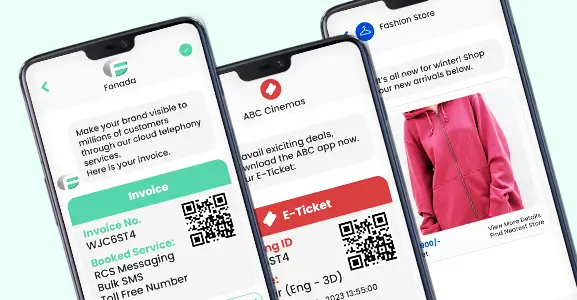API integration in contact centers refers to the seamless connection and communication between different software applications through API. It serves as a bridge that allows one application to access and use the functionalities of another. This facilitates smooth data exchange and coordination. APIs such as messaging API, Whatsapp Businesses API, Calling API, etc, are designed to level up call centers’ operations and productivity.
Also, with the help of these APIs contact center agents can fetch a comprehensive view of customer information in real time using this tool. It empowers agents to provide more personalized and informed assistance to customers.
This blog emphasizes the significance of API integration and its role in enabling call centers to provide a seamless customer experience while maximizing agents’ productivity.
If you are keen on enhancing your understanding of API integration, this blog post is highly beneficial for you. We recommend reading it thoroughly to become well-versed in this technology.
So let’s get started…
What Is An API?
API is the abbreviation of Application Programming Interface, a set of rules that enables different software apps to communicate.
It defines the methods that enable data format applications to request and exchange information with others. It facilitates interoperability between diverse systems and promotes seamless integration and efficient collaboration in software development.
For example, Let’s suppose a weather application uses weather data API to fetch real-time weather information from a remote server. Instead of the app having to go through the intricacies of how the weather data is collected and processed. It simply sends a request to the API, which then returns the relevant information in a standardized format.
The API acts as an intermediary between two entities, allowing the app to access the desired data without needing to comprehend the complexities of the underlying weather service.
Read More: How To Leverage Whatsapp API For Your Business ?
What Is API Integration? (+ Definition)
API integration is a well-structured process of connecting and combining different software systems through their Application Programming Interfaces (APIs). It enables smooth interaction and data exchange between applications. With API integration, applications work together cohesively. The aim of the API integration is to streamline processes, enhance functionality, and improve overall efficiency.
Types Of API Integration
API integration can be categorized into various types based on the nature and purpose of the interaction. Here are some common types of API integration:
Messaging API Integration
RESTful Messaging API: Commonly used for sending and receiving messages via HTTP requests. It could involve endpoints for sending messages, retrieving message history, or managing contacts.
Webhooks for Real-time Messaging: Utilizing webhooks to receive real-time notifications when new messages arrive or when certain events occur.
Calling API Integration
Telephony API: Involves RESTful Voice Calling API endpoints for initiating and managing phone calls. This could include making outbound calls, handling incoming calls, and managing call states.
WebRTC Integration: Utilizing WebRTC (Web Real-Time Communication) for browser-based voice and video calling. This involves handling signaling and media streaming through API calls.
Phone Verification API Integration
RESTful Phone Verification API: Involves API endpoints for initiating phone number verification requests, checking verification status, and handling errors.
One-Time Password (OTP) via SMS: Integration with a messaging API to send OTPs for phone verification.
REST API Integration
Standard RESTful API: Utilizes HTTP methods like GET, POST, PUT, and DELETE for various operations such as retrieving data, creating resources, updating information, and deleting records.
Token-based Authentication: Secure the REST API using tokens (e.g., OAuth2) for authentication and authorization.
Each type of API integration serves a specific purpose in these contexts:
- Messaging API: For communication via text messages or multimedia messages.
- Calling API: For voice and video call initiation and management.
- API for Phone Verification: The phone verification API verifies users’ identities through their phone numbers.
- REST API: For general-purpose data retrieval, creation, and manipulation.
These integrations can be combined or used independently based on the requirements of the application or system being developed.
Benefits Of API Integration In Call Center Operations
The integration of APIs (Application Programming Interfaces) in a call center brings a human touch to the operational landscape, offering a myriad of benefits that enhance efficiency, customer experience, and overall effectiveness.
Here are the prime advantages that API brings to call centers:
Streamline Operations And Processes
API integration transforms your call center into a symphony of seamless communication between systems like CRMs, databases, and ticketing tools. This approach not only eliminates the need for tedious manual data entry but also ensures that your agents are equipped with the latest information. It’s like having a well-coordinated team that effortlessly collaborates to provide the best support.
Elevate Customer Experience (CX)
Through API integration, call center agents gain a panoramic view of customer data and history. This allows them to facilitate personalized and efficient customer service, which creates a connection that goes beyond scripted interactions. Quick access to relevant information empowers agents to resolve issues promptly, resulting in heightened customer satisfaction.
Boost Agent Productivity
API integration empowers your team to be more engaged and customer-centric, transforming the call center into a hub of meaningful interactions.
Real-Time Data & Analytics
API integration facilitates seamless data synchronization across various systems. This ensures that every connected application is in the queue with the most current information. This fosters accurate reporting and analytics. Real-time updates act as the tool for customer engagement that drives faster decision-making, adding a sense of immediacy to your call center’s operational melody.
Multi-Channel Support
Imagine your call center seamlessly connecting with customers through various channels like social media, email, and chat. APIs enable this multi-channel experience, creating a consistent symphony for customers and simplifying the process for agents. It’s about providing a melody of communication options that resonate with today’s diverse customer preferences.
Scalability
As your business evolves, new applications or services can be easily integrated without dismantling the existing infrastructure. This flexibility allows your call center to adapt to changing needs, ensuring scalability.
Cost Savings
API integration performs a cost-saving ballet, automating tasks to reduce manual labor, minimizing the chances of errors, and accelerating processes. These efficiencies translate into savings, not just in terms of costs but also in the harmony of improved customer retention and increased revenue through superior service.
Customization And Innovation
API integration empowers call centers to craft a customized performance tailored to specific business needs. It’s like having the flexibility to choose the correct tools and solutions that suit your business architecture. Furthermore, it allows for the adoption of innovative technologies and services without the need for an extensive development symphony, keeping your call center competitive and in tune with the latest trends.
In essence, API integration transforms the call center into a symphony of streamlined processes, elevated customer experiences, and adaptable scalability, all orchestrated with a human touch.
Read More: Top 10 Best Instant Messaging (IM) Platforms In India
How Do API Integrations Make Your Customer Support Service More Efficient?
API integrations bring a human touch to support operations by streamlining and enhancing various aspects of the process. Here’s a closer look at how these integrations contribute to a more efficient and customer-centric support experience:
Automation
API integrations offer a seamless and automated flow of data between different systems. In the realm of customer support, this means that relevant information effortlessly glides between support platforms, CRMs, instant messaging applications, and other essential systems, eliminating the need for manual intervention.
Real-Time Insights
By allowing real-time updates between systems, API integrations ensure that support agents are constantly in sync with the latest information about customers, their issues, and previous interactions. This real-time data accessibility facilitates the delivery of prompt and accurate responses to customer queries.
Centralized Customer Insight
Through API integrations, support teams create a centralized hub for customer data, presenting a unified interface for easy access. This removes the need for support agents to navigate through a maze of applications. It reduces the time and effort invested in addressing customer concerns.
Top API Use Cases For Customer Support
Customer support is the most valuable aspect of business, and leveraging APIs (Application Programming Interfaces) can enhance its efficiency and effectiveness. Here are some top API use cases for customer support:
Customer Information Retrieval
Scenario: When someone calls your support line, you want your agents to know who they’re talking to, right? With API integration, your phone system can quickly check your customer database for details.
Example: A customer named Sarah calls. With API, the agent instantly sees that Sarah bought a red dress last month and had a question about sizing. This helps the agent provide a better, personalized service.
Automatic Call Logging
Scenario: After a call ends, it’s like wrapping up a package – you want to put it in the right place. API integration lets your call system automatically update your customer record in a reliable digital space (CRM).
Example: After talking to a customer about a billing issue, the system automatically writes down the date, time, and what was discussed in the notebook. It’s like having a digital diary of every conversation.
Payment Processing
Scenario: Sometimes, customers want to buy things during a call. With API powers, your system can connect to a secure payment tool without the agent having to transfer them elsewhere.
Example: A customer decides to purchase a new gadget over the phone. The agent clicks a button, and the system uses a secure tool to handle the payment right there. It’s quick, easy, and safe.
Real-Time Language Translation
Scenario: Your customers might speak different languages, but you want them all to feel heard. API integration can translate languages on the fly, making communication smoother.
Example: A customer speaks Spanish, and the agent doesn’t. With the language API, the system instantly translates the conversation for both, making sure they understand each other perfectly.
In a nutshell, API integration in a call center is like giving your systems special powers to talk to each other. It helps agents be super-efficient and provide top-notch service to customers.
Learn More: How To Use WhatsApp For Business? (+ Top 10 Tips & Tricks)
How To Choose The Best API Integration Service?
There are several api integration services that claim to be perfect for your needs but end up offering less than you expected, That is the reason why Choosing the best API integration service becomes crucial.
Here are some parameters that businesses should follow before selecting a service provider
Compatibility With Your Systems
Make sure the API integration service works well with the systems and software your call center is already using. It should seamlessly fit into your existing setup without causing conflicts.
Ease Of Use
Look for a service that’s easy to use and doesn’t require a steep learning curve. You want something that your team can quickly adapt to without extensive training.
Reliability
The API service should be reliable and stable. You don’t want your call center operations to be disrupted due to technical glitches or downtime.
Scalability
Consider whether the API service can scale along with your call center’s growth. It should be able to handle increased call volumes and additional features as your business expands.
Security
Ensure that the API integration service prioritizes security. Call centers deal with sensitive customer information, so the API must have robust and strong security standards to protect the sensitive data.
Cost
Understand the pricing structure of the API service. Look for a solution that efficiently fits within your budget and offers good value for the features provided.
Support And Documentation
Check if the API service provider offers good customer support and has comprehensive documentation. This ensures that you can get help when needed and can easily understand how to use the service.
Reviews And Reputation
Look for reviews or feedback from other call centers that have used the API service. A good reputation and positive experiences from similar businesses can give you confidence in your choice.
Compliance
Ensure that the API integration service complies with relevant industry regulations and standards. This is crucial, especially in sectors with specific legal requirements, such as healthcare or finance.
By considering the above-listed factors, you can make an informed decision when choosing the best API integration service for your call center. It’s all about finding an accurate solution that fits your business needs.
FAQs
API Integration is linking different software systems, allowing them to communicate and share data seamlessly, enhancing functionality and efficiency across applications.
API integration strategy outlines a plan for connecting diverse applications cohesively. It involves selecting appropriate APIs, defining data flow, and ensuring compatibility for smooth system interaction.
Common API integration use cases include:
- Connecting CRM with marketing tools
- Integrating payment gateways for e-commerce
- Linking social media platforms
- Streamlining data exchange between diverse business applications
API Integration is crucial as it enables seamless communication between applications, ensuring synchronized data flow. This enhances business agility, reduces manual effort, and fosters innovation in a connected digital ecosystem.
APIs establish a framework of rules and protocols governing how software components should interact ?. Integration involves connecting to an API, sending requests, receiving and interpreting responses, and handling data in a way that suits the needs of the integrating systems.
Common challenges include versioning issues, security concerns, data format mismatches, rate limiting, and changes in API endpoints. Addressing these challenges requires careful planning and robust error handling.
Webhooks are a way for one system to notify another system about events, without the need for the second system to constantly poll the first one. They are commonly used in real-time data updates and event-driven architectures.
API integration streamlines data exchange between applications, fostering automation, real-time updates, and improved user experiences. It enhances efficiency, scalability, and overall business functionality.

Dec 11, 2024
Top Contact Center Optimization Tools For 2024
“A thriving business knows how to fetch maximum output from limited resources by optimizing ca... Read More
Nov 13, 2024
What Is Brand Communication? CPaaS Role Explained
Did you ever wonder why some advertisements grab your attention instantly, while others do not? The... Read More
Nov 01, 2024
What Is Automated Messaging And How Does It Work?
Automated messaging or text automation empowers businesses and marketing professionals to connect wi... Read MoreLatest Updates
From Fonada
Industry Insights, Trends, Innovations, Updates, and Case Studies from Industry Experts
View
Customer
Reviews
Discover why our customers love us - read their authentic and heartfelt reviews!
View
Case
Studies
Explore real-life scenarios, offering analysis, and solutions to practical challenges
View
Convert Leads Into Sales With Fonada
Trusted CPaaS Solution Provider








